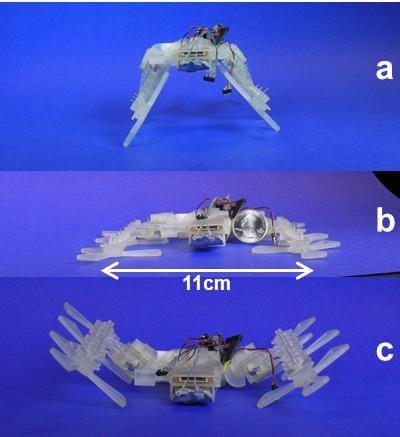Science Fiction
Dictionary
A B C D E F G H I J K L M N O P Q R S T U V W X Y Z
The STAR Robot - From Minority Report?

The STAR (Sprawl Tuned Autonomous Robot) is a 3D-printed robot modeled after an insect's ability to squeeze into even the tiniest spaces. It was developed by students at UC Berkeley's Biomimetic Millisystems Lab. the STAR is able to flatten its legs down to slip under a small gap and then raise them up again to climb over larger obstacles.

(STAR (Sprawl Tuned Autonomous Robot))
With the exception of the electronics, each component of the STAR was built using a ProJet 3000 3D printer, meaning a full robot can be manufactured quickly and cheaply. The main core of the bot holds its control board and battery, which are connected to the six individual legs that propel it forward. Each of the legs has three spokes measuring 2.8 cm (1.1 in) with a 90-degree gap between them, which allow it to crawl over obstacles 4 cm (1.6 in) higher than if it just had wheels.A brushed DC motor provides motion to each set of legs, while a 300 mA/hr LiPo 4V battery gives it enough power to run at full speed for 30 minutes on a single charge. Altogether, the tiny robot weighs just 73 g (2.6 oz).
What really sets the STAR apart from other robots, though, is its ability to adjust its sprawl angle (i.e. the angle between its body and legs) over a range of 150 degrees to adapt to different situations. Depending on the angle, the robot can move faster over different surfaces, climb over taller objects, or slip into narrow passageways, among other tasks.
At a sprawl angle of zero degrees, the robot lays flat on the ground and has a height of just 2.5 cm (1 in), a length of only 12 cm (4.7 in) and a width of 11 cm (4.3 in). It can't actually move in this position, but by changing its sprawl just a few degrees, the robot's legs can touch the ground to move underneath an obstacle, such as a door, without gaining much height. At a 90-degree sprawl, the robot can fit through smaller vertical spaces and travel over rough terrain more easily.
Fans of Steven Spielberg's film Minority Report recall the spider robots, which were able slip easily under doors. Start the video below at about 1 minutes.
Via Gizmag; thanks to an anonymous reader for contributing the tip on this story. I'm traveling this week, and it's much harder for me to look for stories.
Scroll down for more stories in the same category. (Story submitted 8/1/2013)
Follow this kind of news @Technovelgy.| Email | RSS | Blog It | Stumble | del.icio.us | Digg | Reddit |
Would
you like to contribute a story tip?
It's easy:
Get the URL of the story, and the related sf author, and add
it here.
Comment/Join discussion ( 0 )
Related News Stories - (" Robotics ")
Proof Of Robothood - Not A Person
'Who are you people? - Show 'em.' - James Cameron (1984).
Dancing Robots Taught Dance Moves
'A clockwork figure would be the thing for you...' Jerome K. Jerome, 1893.
Factory Humanoid Robots Built By Humanoid Robots
'...haven't you a section of the factory where only robot labor is employed?' - Isaac Asimov (1940).
Mornine Sales Robot
'Robot-salesmen were everywhere, gesturing...' - Philip K Dick, 1954.
Technovelgy (that's tech-novel-gee!) is devoted to the creative science inventions and ideas of sf authors. Look for the Invention Category that interests you, the Glossary, the Invention Timeline, or see what's New.
Science Fiction
Timeline
1600-1899
1900-1939
1940's 1950's
1960's 1970's
1980's 1990's
2000's 2010's
Current News
Natural Gait With Prosthetic Connected To Nervous System
'The leg was to function, in a way, as a servo-mechanism operated by Larry’s brain...'
Woman Marries Computer, Vonnegut's Dream Comes True
'Men are made of protoplasm... Lasts forever.'
Spidery 'Walk Me' Toyota Autonomous Wheel Chair Like Star Wars
Walk along with the emperor.
Dancing Robots Taught Dance Moves
'A clockwork figure would be the thing for you...'
Proof Of Robothood - Not A Person
'Who are you people? - Show 'em.'
Indonesian Clans Battle
'The observation vehicle was of that peculiar variety used in conveying a large number of people across rough terrain.'
The 'Last Mile' In China Crowded With Delivery Robots
Yes, it's a delivery robot. On wheels.
Tornyol Microdrone Kills Mosquitoes
'The real border was defended by... a swarm of quasi-independent aerostats.'
PLATO Spacecraft, Hunter Of Habitable Planets, Now Ready
'I ... set my automatic astronomical instruments to searching for a habitable planet.'
Factory Humanoid Robots Built By Humanoid Robots
'...haven't you a section of the factory where only robot labor is employed?'
iPhone Air Fulfils Jobs' Promise From 2007 - A Giant Screen!
'... oblongs were all over the floor and surfaces.'
ChatGPT Now Participates in Group Chats
'...the city was their laboratory in human psychology.'
iPhone Pocket All Sold Out!
'A long, strong, slender net...'
Did The Yautja Have These First?
What a marvel of ingenuity the little device was!
Jetson ONE Air Races Begin, Can Air Polo Be Far Behind?
'If you're one of those rarities who haven't attended a rocket-polo "carnage", let me tell you it's a colorful affair.'
Will Space Stations Have Large Interior Spaces Again?
'They filed clumsily into the battleroom, like children in a swimming pool for the first time, clinging to the handholds along the side.'
